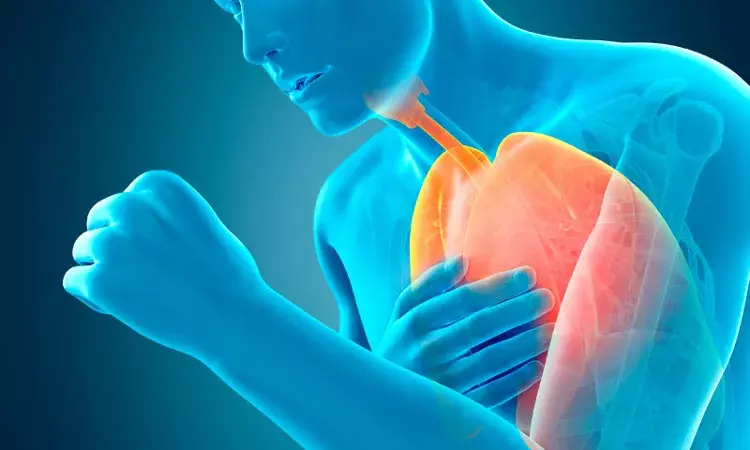- Home
- Medical news & Guidelines
- Anesthesiology
- Cardiology and CTVS
- Critical Care
- Dentistry
- Dermatology
- Diabetes and Endocrinology
- ENT
- Gastroenterology
- Medicine
- Nephrology
- Neurology
- Obstretics-Gynaecology
- Oncology
- Ophthalmology
- Orthopaedics
- Pediatrics-Neonatology
- Psychiatry
- Pulmonology
- Radiology
- Surgery
- Urology
- Laboratory Medicine
- Diet
- Nursing
- Paramedical
- Physiotherapy
- Health news
- Fact Check
- Bone Health Fact Check
- Brain Health Fact Check
- Cancer Related Fact Check
- Child Care Fact Check
- Dental and oral health fact check
- Diabetes and metabolic health fact check
- Diet and Nutrition Fact Check
- Eye and ENT Care Fact Check
- Fitness fact check
- Gut health fact check
- Heart health fact check
- Kidney health fact check
- Medical education fact check
- Men's health fact check
- Respiratory fact check
- Skin and hair care fact check
- Vaccine and Immunization fact check
- Women's health fact check
- AYUSH
- State News
- Andaman and Nicobar Islands
- Andhra Pradesh
- Arunachal Pradesh
- Assam
- Bihar
- Chandigarh
- Chattisgarh
- Dadra and Nagar Haveli
- Daman and Diu
- Delhi
- Goa
- Gujarat
- Haryana
- Himachal Pradesh
- Jammu & Kashmir
- Jharkhand
- Karnataka
- Kerala
- Ladakh
- Lakshadweep
- Madhya Pradesh
- Maharashtra
- Manipur
- Meghalaya
- Mizoram
- Nagaland
- Odisha
- Puducherry
- Punjab
- Rajasthan
- Sikkim
- Tamil Nadu
- Telangana
- Tripura
- Uttar Pradesh
- Uttrakhand
- West Bengal
- Medical Education
- Industry
Compared to dual therapy, Triple therapy doesn`t improve survival in COPD: Study

Recent research reveals that no differences in mortality between LAMA+LABA and triple therapy in patients with moderate-to-very severe COPD and predominantly low risk of exacerbations.
The study was presented at the American Thoracic Society (ATS) 2021 International Conference, held virtually from May 14 to May 19, 2021.
Recent studies report a possible mortality benefit of treatment with long-acting muscarinic antagonist (LAMA)/long-acting β2-agonist (LABA)/inhaled corticosteroid (ICS) versus LAMA/LABA combinations in patients with highly symptomatic COPD and a history of exacerbations.
Hence, M. Miravitlles and colleagues from the Pneumology Department, Hospital Universitari Vall d'Hebron, Vall d'Hebron Research Institute (VHIR), Barcelona, Spain compared the time to all-cause mortality with LAMA/LABA/ICS versus LAMA+LABA in a population of patients with predominantly moderate-to-severe COPD and a predominantly lower exacerbation risk.
Data were pooled from patients who participated in six phase 3/4 randomized controlled trials and received treatment with either LAMA/LABA/ICS (n=11,891) or LAMA+LABA (n=3,156). There was no withdrawal of prior treatment at randomization in either arm, and the LAMA/LABA/ICS group were receiving ICS prior to study entry.
The analysis was on-treatment and all data were censored at 52 weeks. To address any imbalance in characteristics between treatment arms, analyses were performed in a propensity score (PS)-matched cohort with age, sex, geographical region, smoking status, post-bronchodilator forced expiratory volume in 1 second (FEV1) percent predicted, exacerbation history, body mass index and time since diagnosis as covariates.
Patients were PS-matched to those who received LAMA+LABA during the treatment period and had not previously received ICS. Cox proportional hazard regression models adjusting for covariates were used to assess time to all-cause mortality.
The following findings were seen-
- After propensity score matching, there were 3,133 patients in both the LAMA+LABA and LAMA/LABA/ICS treatment groups.
- Baseline characteristics and comorbidities were well balanced between groups (LAMA+LABA vs. LAMA/LABA/ICS: male: 71.7% vs. 72.0%; age, mean±SD: 65.5±8.8 years vs. 65.5±8.7 years; FEV1% predicted [post-bronchodilator], mean±SD: 48.6±13.2% vs. 48.4±13.3%).
- Groups were composed mostly of infrequent exacerbators (patients with ≥2 COPD exacerbation in prior year: 19.1% vs. 19.0%).
- Overall, there were 41 (1.3%) deaths in the LAMA+LABA group and 45 (1.4%) in the LAMA/LABA/ICS group.
- No statistically significant difference in the time to death was observed between treatment groups (; hazard ratio 1.06; 95% confidence intervals 0.68, 1.64; P=0.806).
- Sensitivity analyses using three additional models with different covariates showed similar results.
Therefore, the authors concluded that "this pooled analysis of over 6,000 PS-matched patients showed no differences in mortality between LAMA+LABA and triple therapy in patients with moderate-to-very severe COPD and predominantly low risk of exacerbations."
Dr. Nandita Mohan is a practicing pediatric dentist with more than 5 years of clinical work experience. Along with this, she is equally interested in keeping herself up to date about the latest developments in the field of medicine and dentistry which is the driving force for her to be in association with Medical Dialogues. She also has her name attached with many publications; both national and international. She has pursued her BDS from Rajiv Gandhi University of Health Sciences, Bangalore and later went to enter her dream specialty (MDS) in the Department of Pedodontics and Preventive Dentistry from Pt. B.D. Sharma University of Health Sciences. Through all the years of experience, her core interest in learning something new has never stopped. She can be contacted at editorial@medicaldialogues.in. Contact no. 011-43720751
Dr Kamal Kant Kohli-MBBS, DTCD- a chest specialist with more than 30 years of practice and a flair for writing clinical articles, Dr Kamal Kant Kohli joined Medical Dialogues as a Chief Editor of Medical News. Besides writing articles, as an editor, he proofreads and verifies all the medical content published on Medical Dialogues including those coming from journals, studies,medical conferences,guidelines etc. Email: drkohli@medicaldialogues.in. Contact no. 011-43720751


